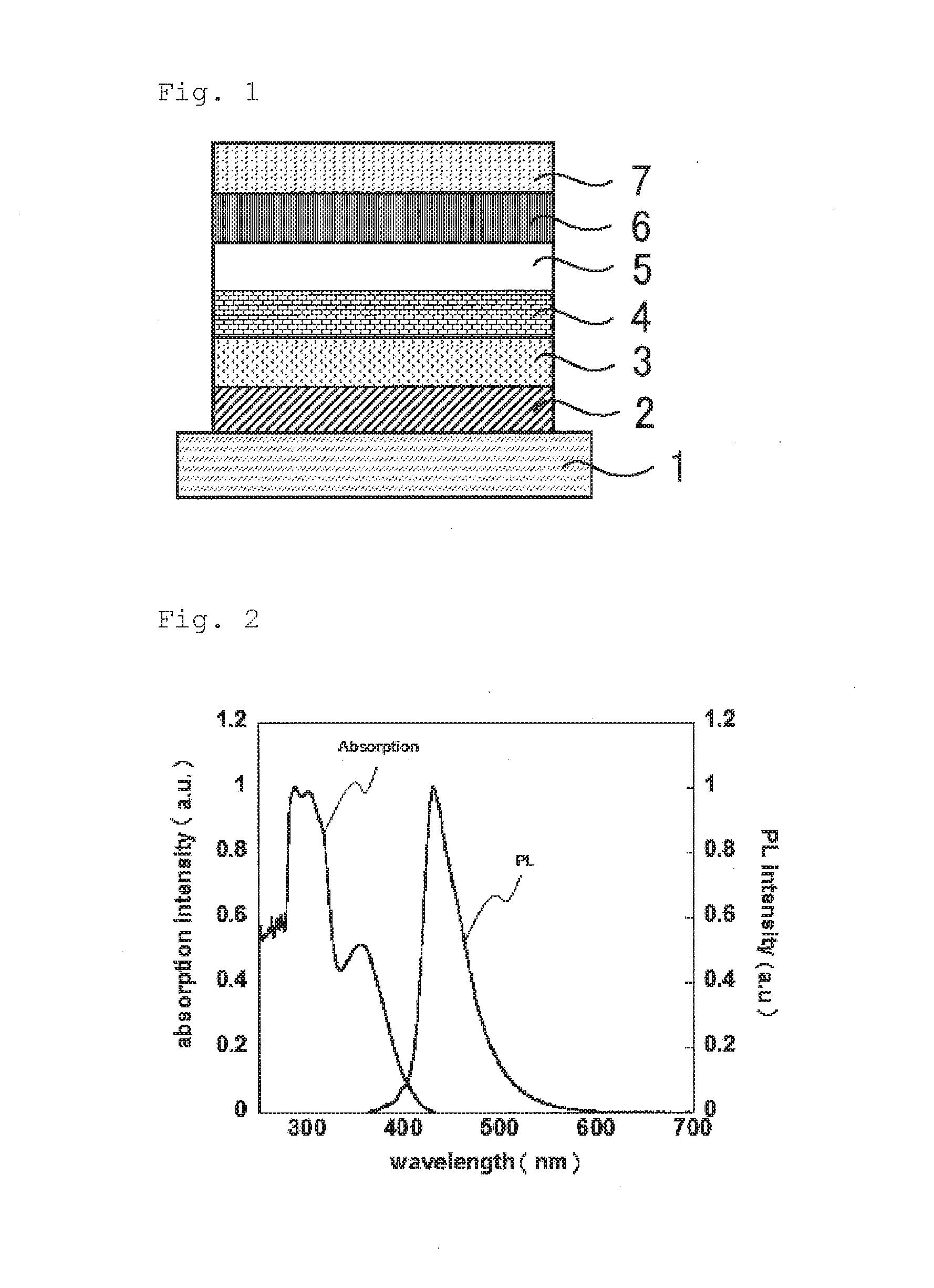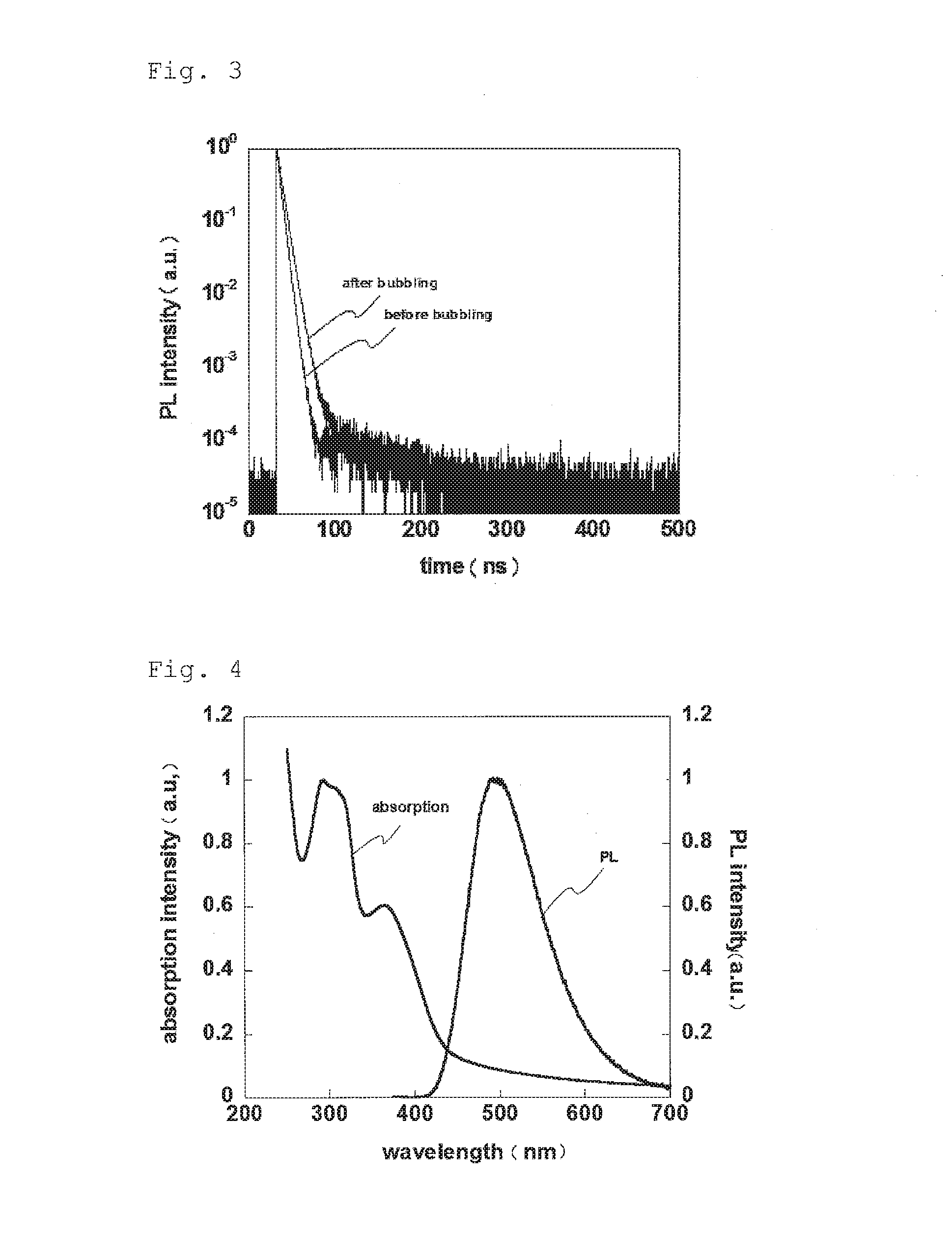Light-emitting material, organic light-emitting device, and compound
- Summary
- Abstract
- Description
- Claims
- Application Information
AI Technical Summary
Benefits of technology
Problems solved by technology
Method used
Image
Examples
synthesis example 1
Synthesis of Compound 1
[0130]
[0131]N, N-Bis(9H-carbazol-3-yl) aniline (0.68 g, 1.6 mmol) and potassium carbonate (0.96 g, 7.2 mmol) were placed in a 100 mL two-necked flask, which was then replaced with nitrogen. Thereafter, 4-fluorobenzonitrile (0.58 g, 4.8 mmol) and dimethylformamide 20 ME) were added thereto, and the mixture was agitated under heating to 100° C. for 24 hours. After naturally cooling to room temperature, water was added thereto, followed by agitating for 10 minutes, and a solid thus deposited was filtered. The solid was dissolved in dichloromethane, and hot filtered. The filtrate was reprecipitated from n-hexane, thereby providing 0.688 g (1.1 mmol, yield: 69%) of the compound 1 as white powder.
[0132]1H NMR (500 MHz, CDCl3): δ 7.97 (d, J=7.8 Hz, 2H; ArH), 7.93 (d, J=8.0 Hz, 2H; ArH), 7.90 (d, J=8.7 Hz, 4H; ArH), 7.76 (d, J=8.7 Hz, 4H; ArH), 7.46-7.38 (m, 6H; ArH) 7.31-7.21 (m, OH; ArH), 7.10 (dd, Jortho=8.7 Hz, Jmeta=1.1 Hz, 2H; ArH), 6.95 (t, J=7.4 Hz, 1H; ArH)
synthesis example 2
Synthesis of Compound 2
[0133]
[0134]Sodium tert-butoxide (0.29 g, 3.0 mmol) was placed in a 100 mL, three-necked flask, and dried in vacuum. Thereafter, after replacing with nitrogen, N, N-bis(9H-carbazol-3-yl) aniline (0.21 g, 0.50 mmol) 2-(4-bromophenyl)-4,6-diphenyl-1, 3, 5-triazine (0.427 g, 1.1 mmol) palladium(II) acetate (13 mg, 0.060 mmol) tri-tert-butylphosphine (0.03 mL, 0.060 mmol), and 20 ml of xylene were added thereto, and the mixture was agitated under heating to 110° C. for 72 hours. After naturally cooling to room temperature, a solid was obtained by filtration. The solid was rinsed with toluene, water, and methanol, and dried in vacuum, thereby providing 0.14 g (0.14 mmol, yield: 27%) of the compound 2 as yellow powder.
[0135]1H NMR (500 MHz, Acetone d6): d=9.14 (d, J=8.5 Hz, 4H; ArH) 8.88 (d, J=7.1 Hz, 8H; ArH), 8.13 (d, J=7.9 Hz, 2H; ArH) 8.12 (s, J=2.0 Hz, 2H; ArH), 7.99 (d, J=8.6 Hz, 4H; ArH) 7.74-7.63 (m, 16H; ArH), 7.49 (t, J=7.3 Hz, 2H; ArH), 7.39 (dd, Jortho=8...
synthesis example 3
Synthesis of Compound 3
[0136]
[0137]Sodium tert-butoxide (1.2 g, 12 mmol) was placed in a 300 ml three-necked flask, and dried in vacuum. Thereafter, after replacing with nitrogen, N, N-bis(9H-carbazol-3-yl) aniline (0.85 g, 2.0 mmol), 2-(4-bromophenyl)-benzothiazole (1.3 g, 4.4 mmol), palladium (II) acetate (54 mg, 0.24 mmol) tri-tert-butylphosphine (0.12 mL, 0.24 mmol), and xylene (20 mL) were added thereto, and the mixture was agitated under heating to 100° C. for 22 hours. After naturally cooling to room temperature, the reaction, solution was concentrated with an evaporator, and separated with dichloromethane and water. The organic layer was dried over magnesium sulfate, and concentrated with an evaporator. The concentrated solution was purified by column chromatography (stationary phase: silica gel, developing solvent: toluene), and the resulting target compound was purified by sublimation purification, thereby providing 0.90 g (1.07 mmol, yield: 54%) of the compound 3 as a yel...
PUM
 Login to View More
Login to View More Abstract
Description
Claims
Application Information
 Login to View More
Login to View More - R&D
- Intellectual Property
- Life Sciences
- Materials
- Tech Scout
- Unparalleled Data Quality
- Higher Quality Content
- 60% Fewer Hallucinations
Browse by: Latest US Patents, China's latest patents, Technical Efficacy Thesaurus, Application Domain, Technology Topic, Popular Technical Reports.
© 2025 PatSnap. All rights reserved.Legal|Privacy policy|Modern Slavery Act Transparency Statement|Sitemap|About US| Contact US: help@patsnap.com



